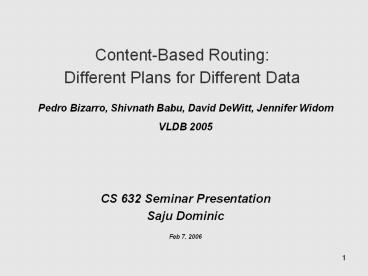ContentBased Routing: Different Plans for Different Data - PowerPoint PPT Presentation
Title:
ContentBased Routing: Different Plans for Different Data
Description:
Content-Based Routing: Different Plans for Different Data ... CS 632 Seminar Presentation. Saju Dominic. Feb 7, 2006. Introduction ... – PowerPoint PPT presentation
Number of Views:48
Avg rating:3.0/5.0
Title: ContentBased Routing: Different Plans for Different Data
1
Content-Based RoutingDifferent Plans for
Different Data
- Pedro Bizarro, Shivnath Babu, David DeWitt,
Jennifer Widom - VLDB 2005
- CS 632 Seminar Presentation
- Saju Dominic
- Feb 7, 2006
2
Introduction
- Different parts of the same data may have
different statistical properties. - Different query plans may be optimal for the
different parts of the data for the same query. - Concurrently run different optimal query plans on
different parts of the data for the same query
3
Overview of CBR
- Eliminates single plan assumption
- Identifies tuple classes
- Uses multiple plans, each customized for a
different tuple class - Adaptive and low overhead algorithm
- CBR applies to any streaming data
- stream systems
- regular DBMS operators using iterators
- and acquisitional systems.
- Implemented in TelegraphCQ as an extension to
Eddies
4
Overview of Eddies
- Eddy routes tuples in a particular order through
a pool of operators - Routing decisions based on operator
characteristics - Selectivity
- Cost
- Queue size
5
Intrusion Detection Query
- Track packets with destination address matching
a prefix in table T, and containing the 100-byte
and 256-byte sequences 0xa...8 and 0x7...b
respectively as subsequence - SELECT FROM packetsWHERE matches(destination,
T)AND contains(data, 0xa...8)AND
contains(data, 0x7...b)
6
Intrusion Detection Query
- Assume
- costs are c3gtc1gtc2
- selectivities are ??3gt?1gt?2
- SBR routing converges to O2, O1, O3
almost all tuples follow this route
7
Intrusion Detection Query
- Suppose an attack (O2 and O3) on a network whose
prefix is not in T (O1) is underway - sO2 and sO3 will be very high, sO1 will be very
low - O1, O2, O3 will be the most efficient ordering
for attack tuples
almost all tuples follow this route
8
Content-Based Routing Example
- Consider stream S processed by O1, O2, O3
9
Content-Based Routing Example
- Let A be an attribute with domain a,b,c
10
Classifier Attributes
- Goal identify tuple classes
- Each with a different optimal operator ordering
- CBR considers
- Tuple classes distinguished by content, i.e.,
attribute values - Classifier attribute (informal definition)
- Attribute A is classifier attribute for operator
O if the value of A is correlated with
selectivity of O.
11
Best Classifier Attribute Example
- Attribute A with domain a, b, c
- Attribute B with domain x, y, z
- Which is the best to use for routing decisions?
- Similar to AI problem classifier attributes for
decision trees - AI solution Use GainRatio to pick best
classifier attribute
12
GainRatio to Measure Correlation
GainRatio(R, A) 0.87 GainRatio(R, B)
0.002
- R random sample of tuples processed by operator O
13
Classifier AttributesDefinition
- An attribute A is a classifier attribute for
operator O, if for any large random sample R of
tuples processed by O, GainRatio(R,A)gt??, for
some threshold ?
14
Content-Learns AlgorithmLearning Routes
Automatically
- Content-Learns consists of two continuous,
concurrent steps - Optimization For each Ol ? O1, ,On find
- that Ol does not have a classifier attribute or
- find the best classifier attribute, Cl, of Ol.
- Routing Route tuples according to the
- selectivities of Ol if Ol does not have a
classifier attribute or - according to the content-specific selectivities
of the pair ltOl, Clgt if Cl is the best classifier
attribute of Ol
15
Content-Learns Optimization Step
- Find Cl by profiling Ol
- Route a fraction of input tuples to Ol
- For each sampled tuple
- For each attribute
- map attribute values to d partitions
- update pass/fail counters
- When all sample tuples seen, compute Cl
sampled tuple
corresponding partitions
16
Content-Learns Routing Step
- SBR routes to Ol with probability inversely
proportional to Ols selectivity, Wl - CBR routes to operator with minimum??
- If Ol does not have a classifier attribute, its
?Wl - If Ol has a classifier attribute, its ?Sl,i,
jCAl, ifj(t.Cj)
17
Adaptivity and Overhead
- CBR introduces new routing and learning overheads
- Overheads at odds with adaptivity
- Adaptivity ability to find efficient plan
quickly when data or system characteristics change
18
CBR Update Overheads
- Once per tuple
- selectivities as fresh as possible
- Once per sampled tuple
- correlations between operators and content
- Once per sample (2500 tuples)
- Computing GainRatio and updating one entry in
array CA
attributes 1,,k
19
Experimental ResultsRun-time Overheads
- Routing overhead
- time to perform routing decisions (SBR, CBR)
- Learning overhead
- Time to update data structures (SBR, CBR) plus
- Time to compute gain ratio (CBR only).
20
Experimental ResultsVarying Skew
- One operator with selectivity A, all others with
selectivity B - Skew is A-B. A varied from 5 to 95
- Overall selectivity 5
21
Experimental ResultsRandom Selectivities
- Attribute attrC correlated with the selectivities
of the operators - Other attributes in stream tuples not correlated
with selectivities - Random selectivities in each operator
22
Experimental ResultsVarying Aggregate
Selectivity
- Aggregate selectivity in previous experiments was
5 or 8 - Here we vary aggregate selectivity between 5 to
35 - Random selectivities within these bounds
23
Experimental ResultsVarying Skew
- One operator with selectivity A, all others with
selectivity B - Skew is A-B. A varied from 5 to 95
- Overall selectivity 5
24
Conclusions
- CBR eliminates single plan assumption
- Explores correlation between tuple content and
operator selectivities - Adaptive learner of correlations with negligible
overhead - Performance improvements over non-CBR routing































